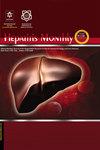Serum Peptidyl-prolyl Cis-trans Isomerase NIMA-interacted 1 (Pin1) as a Non-invasive Marker for Liver Fibrosis due to Chronic Hepatitis C Virus.
IF 0.6
4区 医学
Q4 GASTROENTEROLOGY & HEPATOLOGY
引用次数: 0
Abstract
Background: Hepatitis C virus (HCV) may remain asymptomatic or cause liver fibrosis and cirrhosis. Objectives: We aimed to assess the relationship between serum peptidyl-prolyl cis-trans isomerase NIMA-interacted 1 (Pin1) levels and liver fibrosis due to HCV. Methods: Serum samples of successive patients with HCV genotype 1b and healthy volunteers were collected, and Pin1 levels were measured using ELISA kits. Liver fibrosis stages were calculated by the Ishak Scoring System and subdivided into two groups; stage < 3 (mild fibrosis) and ≥ 3 (advanced fibrosis). Correlation and area under receiver operating characteristics (AUROC) analysis were used to investigate the relationship between Pin1 and clinical and histopathological properties of HCV infection. Results: Ninety-four patients with HCV and 47 age- and sex-matched volunteers were included. The median age of the participants was 52, and 55% of whom were females. The mean (SD) of Pin1 serum level was significantly higher in the HCV group compared with healthy volunteers (33.94 (21.15) vs. 26.82 (8.85) pg/mL, respectively, P = 0.007). Seventy-seven (82%) and 17 (18%) of the participants showed mild and advanced fibrosis, respectively. Pin1 serum levels were significantly lower in the mild compared with advanced fibrosis group (29 (17.88) vs. 43.59 (7.98) pg/mL, respectively, P < 0.001). We found a significantly positive correlation between Pin1 serum level and liver fibrosis stage (r = 0.71, P < 0.001). The cut off of 33.04 pg/mL of Pin1 serum level showed the best sensitivity (100%) and specificity (68.4%) (AUROC = 0.81 [95% confidence interval: 0.72 - 0.90], P < 0.001) for distinguishing advanced from mild liver fibrosis. Conclusions: Serum Pin1 level may be a relevant marker for predicting liver fibrosis in HCV infected patients.血清肽酰脯氨酸顺式反式异构酶nima相互作用1 (Pin1)作为慢性丙型肝炎病毒所致肝纤维化的非侵入性标志物
背景:丙型肝炎病毒(HCV)可能保持无症状或引起肝纤维化和肝硬化。目的:我们旨在评估血清肽酰脯氨酸顺式反式异构酶1 (nima -相互作用1)水平与丙型肝炎肝纤维化之间的关系。方法:连续收集HCV基因型1b患者和健康志愿者的血清样本,采用ELISA试剂盒检测Pin1水平。采用Ishak评分系统计算肝纤维化分期,并细分为两组;分期< 3(轻度纤维化)和≥3(晚期纤维化)。采用相关性分析和AUROC (area under receiver operating characteristic)分析Pin1与HCV感染临床和组织病理学特征的关系。结果:纳入94例HCV患者和47名年龄和性别匹配的志愿者。参与者的年龄中位数为52岁,其中55%为女性。HCV组血清Pin1水平均值(SD)显著高于健康志愿者(33.94 (21.15)vs. 26.82 (8.85) pg/mL, P = 0.007)。77名(82%)和17名(18%)的参与者分别表现为轻度和晚期纤维化。与晚期纤维化组相比,轻度纤维化组血清Pin1水平显著降低(分别为29(17.88)比43.59 (7.98)pg/mL, P < 0.001)。我们发现血清Pin1水平与肝纤维化分期呈正相关(r = 0.71, P < 0.001)。血清Pin1水平以33.04 pg/mL为临界值,是区分晚期和轻度肝纤维化的最佳敏感性(100%)和特异性(68.4%)(AUROC = 0.81[95%可信区间:0.72 ~ 0.90],P < 0.001)。结论:血清Pin1水平可能是预测HCV感染患者肝纤维化的相关指标。
本文章由计算机程序翻译,如有差异,请以英文原文为准。
求助全文
约1分钟内获得全文
求助全文
来源期刊

Hepatitis Monthly
医学-胃肠肝病学
CiteScore
1.50
自引率
0.00%
发文量
31
审稿时长
3 months
期刊介绍:
Hepatitis Monthly is a clinical journal which is informative to all practitioners like gastroenterologists, hepatologists and infectious disease specialists and internists. This authoritative clinical journal was founded by Professor Seyed-Moayed Alavian in 2002. The Journal context is devoted to the particular compilation of the latest worldwide and interdisciplinary approach and findings including original manuscripts, meta-analyses and reviews, health economic papers, debates and consensus statements of the clinical relevance of hepatological field especially liver diseases. In addition, consensus evidential reports not only highlight the new observations, original research, and results accompanied by innovative treatments and all the other relevant topics but also include highlighting disease mechanisms or important clinical observations and letters on articles published in the journal.
 求助内容:
求助内容: 应助结果提醒方式:
应助结果提醒方式:


